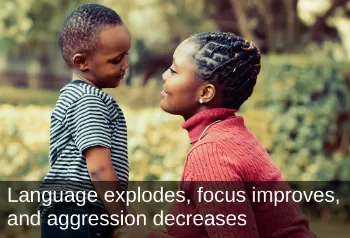Primitive Reflex Integration Case Studies
Decreased Aggression; Increased Focus and Speech
From little to no verbal interaction to chatting with family!
In addition to speech challenges, this young boy had separation anxiety, an inability to focus, and social/behavioral issues. See how rhythmic movements help with speech challenges and more.
Submitted by Carrie Eskenazi Speech-Language Pathologist

| Before | After |
|---|---|
| Little to no verbal interaction | Makes verbal choices; chats about his family |
| Difficulty separating from parents | Separates easily from parents |
| Inability to focus | Stays on task |
| No parallel or pretend play | Participates in reciprocal play |
| Hard to handle | Physical aggression toward mother has decreased greatly |
S.T. is a 4-year-old boy who came to me with little to no verbal interaction, poor eye contact, no parallel play skills, no pretend play skills, difficulty separating from parents, and little to no focused attention for play and other tasks.
I chose rhythmic rocking [from the Brain and Sensory Foundations course] for this student because he did not want to be touched and would not be still long enough to assess. I demonstrated rhythmic rocking for his parents and demonstrated briefly with S.T.
.
I told S.T.’s parents to start doing rhythmic rocking with him while he slept since he did not want to lie down or be still for long enough to do it with me or with them. They began doing rhythmic rocking with him right away while he slept and began trying it with him while awake.
- Within 2 weeks, he was requesting it from his parents multiple times a day.
- Within 4 weeks, he was separating easily from his parents and his attention to tasks had increased greatly.
- Within 6 weeks, he was greeting me, making verbal choices, participating in reciprocal play and having an expressive language explosion.
- Within 10 weeks, he was sharing stories about his family with me and physical aggression toward his mother had decreased greatly.
- Other changes took place in his body, such as increased mucus/itchiness, increased body awareness, increased engagement with his environment.
I learned that rhythmic movements really worked for him and were a good place to start given that he did not like touch from others and that he typically was not still for more than a few seconds. This was my first ‘experiment’ with the rhythmic movements and I began using them with many other clients.
S.T. changed rapidly from session to session. His original goals were met quickly and this fall, he is in a regular pre-school classroom and doing well. I have added some reflex integration work with him as well during therapy sessions and parents continue to do rhythmic rocking at home.
[Edited for length and clarity; emphasis added]
*Disclaimer: The activities in the Brain and Sensory Foundations curriculum make use of the natural processes of neuroplasticity and development that are innately wired in the design of human beings to promote maturity and function. These activities appear to calm, organize, and mature the neuro-sensory-motor systems just as we see in the healthy development of human infants. Individual results may vary, and we do not claim to offer a diagnosis or cure for any specific condition or disorder. The Brain and Sensory Foundations activities appear to improve overall functioning resulting in measurable improvements for a range of conditions as demonstrated in over 1800 case studies from participants.

